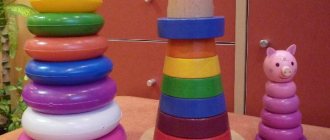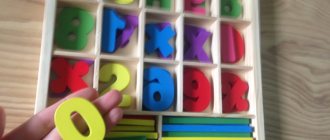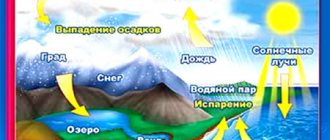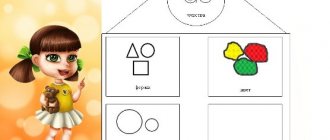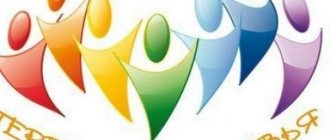Pedagogical project on the topic: “Mathematics is interesting”
- February 12, 2018
International and All-Russian competitions
All-Russian conference “Pedagogical project in a preschool educational institution”
Explanatory note for the project “Mathematics is interesting!”
Relevance of the project
Mathematics is a powerful factor in the intellectual development of a child, the formation of his cognitive and creative abilities. It is also known that the success of teaching mathematics in primary school mathematical .
Mathematics for children is most important in terms of memory development and further perception of mathematical information . For a more effective introduction of mathematics into the child’s mind , its study should, of course, begin in kindergarten. Moreover, you don’t have to be afraid of serious geometric shapes and other things. At this age, the child’s brain catches everything down to the smallest detail, and if sometimes the baby does not understand everything, it’s not scary, anyway, some part of the learning process is embedded in his memory, the brain begins to get used to new data. Gradually, after repetitions, the child will easily distinguish geometric shapes and learn to add and subtract.
It is very important in this regard to have the right approach, to work with the child only in a playful way, using the method of games and tips, otherwise strict classes will quickly become a boring time for the child, and he will not want to return to it anymore.
Why do many children find mathematics not only in elementary school, but even now, during the period of preparation for educational activities? Let's try to answer this question and show why generally accepted approaches to the mathematical preparation of a preschool child often do not bring the desired positive results. In modern training programs, important importance is attached to the logical component.
The development of a child’s logical thinking implies the formation of logical techniques of mental activity, as well as the ability to understand and trace the cause-and-effect relationships of phenomena and the ability to build simple conclusions based on cause-and-effect relationships. So that the child does not experience difficulties literally from the first lessons and does not have to learn from scratch, already now, in the preschool period, it is necessary to prepare the child accordingly.
Many parents believe that the main thing in preparing for school is to introduce the child to numbers and teach him to write, count, add and subtract (in fact, this usually results in an attempt to memorize the results of addition and subtraction within 10).
However, when teaching mathematics using textbooks of modern developmental systems, these skills do not help the child in mathematics . The stock of memorized knowledge ends very quickly after a month or two, and the child cannot independently perform the above mental actions on mathematical content , which leads to the appearance of “problems with mathematics .” The relevance of this issue prompted the idea to create the project “Mathematics is interesting!” on mastering children of middle preschool age - the ability to think logically, analyze, develop memory, attention and, most importantly, correctly express their thoughts out loud.
Project goals:
- To contribute to the creation of pedagogical conditions for the development of curiosity in older children, cognitive activity through entertaining developmental material .
- To increase the level of readiness of older preschool children for school.
- To develop the mathematical concepts of children 6-7 years old at an elementary level through the techniques of comparison, generalization, classification, systematization and semantic correlation.
- To promote the formation and development of the simplest logical structures of thinking and mathematical concepts in older preschoolers
Project objectives:
- develop interest in solving cognitive, creative problems, in a variety of intellectual activities;
- develop imaginative and logical thinking, the ability to perceive and display, compare, generalize, classify, modify, etc.;
- develop the ability to establish mathematical connections, patterns, order, the relationship of arithmetic operations, signs and symbols, relationships between parts of the whole, numbers, measurements, etc.;
- develop combinatorial abilities by combining color and shape, development of creative imagination, memory;
- to arouse the desire for a creative process of cognition and the implementation of strict actions according to the algorithm, self-expression in active, interesting, meaningful activities;
- promote the manifestation of children’s research activity in independent mathematical games, in the process of solving problems of various types, the desire to develop the game and search for results with unique, original actions (in their own way, at the level of age capabilities),
- developing interest in games that require mental stress and intellectual effort,
- promote the desire to achieve a positive result, perseverance and resourcefulness,
- formation of basic mathematical concepts and speech skills.
Expected Result:
- Children are active and independent in using mastered methods of cognition (comparing, counting, measuring, ordering) in order to solve practical, problematic problems and transfer them to new conditions.
- Children successfully solve logic problems.
- Show interest in experimentation. They are able to outline successive steps in the development of a situation, follow goals, and choose means.
- Actively involved in classification and series games; offer options; participate in transformation activities.
Methods used:
- Games
- Watching cartoons
- Conversations, quizzes
- Use of fiction
- Consultations for parents
- Creating a math corner in a group
- Demonstration of visual aids
- Presentations
- Application
- Drawing on semolina
Pedagogical project passport
| Structure | Content |
| Subject | “Mathematics is interesting!” |
| Project addressing | Children, teachers and parents of pupils |
| Project Manager | Grushina L.S. - preparatory group teacher Lazarenko N.S. - preparatory group teacher |
| Project participants | Teachers, children, parents |
| Age of pupils | 6-7 years |
| Project Features | By the nature of the product being created: Educational, playful, creative By number of participants: group; Duration: short-term (1 week); By level of contacts: at the level of the educational institution. |
| Objective of the project | — Contribute to the creation of pedagogical conditions for the development of curiosity in older children, cognitive activity through entertaining educational material. — To increase the level of readiness of older preschool children for school. — Develop the mathematical concepts of children 6-7 years old at an elementary level through the techniques of comparison, generalization, classification, systematization and semantic correlation. — To promote the formation and development of the simplest logical structures of thinking and mathematical concepts in older preschoolers. |
| Project objectives | — Develop interest in solving cognitive, creative problems, in a variety of intellectual activities; — Develop imaginative and logical thinking, the ability to perceive and display, compare, generalize, classify, modify, etc.; — Develop the ability to establish mathematical connections, patterns, order, the relationship of arithmetic operations, signs and symbols, relationships between parts of the whole, numbers, measurements, etc.; — Develop combinatorial abilities by combining color and shape, development of creative imagination, memory; — Arouse the desire for a creative process of cognition and the implementation of strict actions according to the algorithm, self-expression in active, interesting, meaningful activities; — To promote the manifestation of children’s research activity in independent mathematical games, in the process of solving problems of various types, the desire to develop the game and search for results through unique, original actions (in their own way, at the level of age capabilities). — Developing interest in games that require mental stress and intellectual effort. — Promote the desire to achieve a positive result, perseverance and resourcefulness. — Formation of basic mathematical concepts and speech skills. |
| Project Resources | Required support: — methodological materials. -fiction: “Three Bears”, “Two Little Bears”, “Twelve Months” by S. Marshak, “Flower - Seven Flowers” by V. Kataev; story by K. Ushinsky “Four Desires”. Memorizing poems about numbers, counting rhymes, riddles about geometric shapes and numbers. — electronic resources (Internet materials). |
| Intended project products | Expected positive results of the project: Products of the teacher’s activity: — Card index of mathematical riddles; graphic dictations by cells; labyrinths; “Entertaining mathematics” (proverbs, sayings, tongue twisters, poems, attention tasks, entertaining questions, logical endings, counting rhymes); Math problems in verse — Albums “Find the differences”, “Right-left, up-down. Orientation in space", "Games with counting sticks", "Didactic games in mathematics" — Summary of the conversation “How people learned to count” — Consultations for parents “Mathematics is interesting!” Memo for parents “Home mathematics: we are together” — Quiz “Guess it” — Didactic games: cut-out pictures “Days of the week and seasons”, “Number houses”, “Count it”, “Repeat the pattern”, “Mathematical scales” — Presentations “Mathematics in the preparatory group”, “Entertaining mathematics” — Creation of a math corner in the group Products of children's activities: -Applique -Drawing Products of parents' activities: — Watching cartoons at home with children “Back in the land of geometry”, “The story of the power of numbers”, “Learning to count from 1 to 20 with the hedgehog Zheka”, “Mathematical quantities” (educational cartoon) — Help from parents in creating didactic games for the group’s math corner. |
Stages of work on the project.
| Stages of work | The content of the work | Expected result |
| First stage: Preparatory Goal: to promote the development of interest in activities Second stage: Main Goal: to contribute to the accumulation of experience and necessary information Third stage Creative Goal: to promote the development, creativity, imagination, necessary practical skills in the artistic and creative activities of children | Introductory conversation with children "How people learned to count" Reading fiction: “Three Bears”, “Two Little Bears”, “Twelve Months” by S. Marshak, “Flower - Seven Flowers” by V. Kataev; story by K. Ushinsky “Four Desires”. Learning poems about numbers, counting rhymes, riddles about geometric shapes and numbers Didactic games: cut-out pictures “Days of the week and seasons”, “Number houses”. Watching cartoons “Island of Errors”, “Tamer of Numbers”. Math games. Guess Quiz Consultations for parents “Mathematics is interesting!” Memo for parents “Home mathematics: we are together.” Presentations “Mathematics in the preparatory group”, “Entertaining mathematics” Didactically games: “Count it”, “Repeat the pattern”, “Mathematical scales”, “Find the differences”, “Right-left, up-down. Orientation in space" Games with counting sticks Evening of entertaining mathematics Creating a math corner in a group Application “Animals from geometric shapes” Drawing geometric shapes on semolina | Summary of the conversation Book exhibition Didactic games: cut-out pictures “Days of the week and seasons”, “Number houses” Album “Didactic games in mathematics” Quiz summary Consultations for parents “Mathematics is interesting!” Memo for parents “Home mathematics: we are together” Presentations “Mathematics in the preparatory group”, “Entertaining mathematics” Didactically games: “Count it”, “Repeat the pattern”, “Mathematical scales” Albums “Find the differences”, “Right-left, up-down. Orientation in space" Album “Games with Counting Sticks” Card file “Entertaining mathematics” (proverbs, sayings, tongue twisters, poems, attention tasks, entertaining questions, logical endings, counting rhymes); "Math problems in verse" Creating a math corner in a group |
